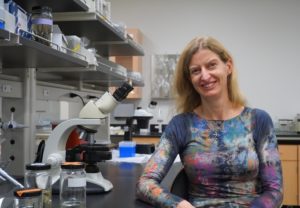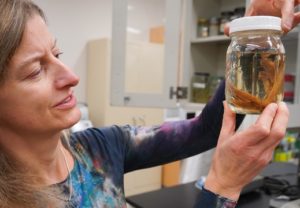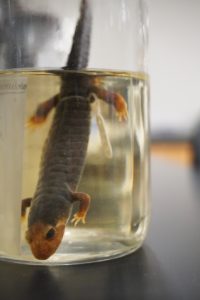When you think of salamanders, you probably think of the small, slimy, lizard-like animals that live under logs and in streams. But did you know that these amphibians are unique right down to their DNA?
Rachel Mueller, a professor in the Department of Biology at CSU, studies salamanders and their cellular makeup. She’s found an interesting quirk in these species’ evolutionary histories – they’re full of “junk” DNA. 
Genetic arms race
Genes are like a set of instructions, telling the cells which proteins to create. In most organisms, however, the majority of DNA doesn’t hold genetic material. Some of this junk DNA is made up of transposons – parasitic, virus-like strands of DNA that replicate selfishly.
Over time, cells evolve to silence their transposons, and the transposons evolve to resist the cells.
“You have this arms race between the cells and their transposable elements,” said Mueller. “Most of our genome is basically just remnants of transposable elements that weren’t silenced by the cell.”

Some salamanders, as well as African lungfish, are losing this arms race – transposons are accumulating in their genomes faster than their cells are silencing them. These species have more transposons than humans, meaning larger genomes and larger cells – 40 times larger, in some cases.
“Each cell is such a large fraction of the organism, I find that really interesting,” said Mueller. In some of the smallest species, a salamander’s developing femur bone may only be two cells wide.
Cell size and body morphology
Currently, Mueller’s lab is studying how cell size influences organ development.
“As the cells get bigger, their organ structure is very different,” said Mueller. “Their hearts are very structurally similar to the phenotypes you see in humans with severe heart failure.”
So, how did this happen? And why did evolution leave these species in such a seemingly unfortunate position? 
“Salamanders have really low metabolic rates, low energetic requirements,” said Mueller. While not ideal, a low-functioning heart or liver is all they need to survive. “They show us what our genomes would probably look like if they weren’t constrained by our physiology.”
Mueller’s lab is examining genetic mutations, which occur when material is replaced in, deleted from, or inserted into a DNA sequence. Salamanders fall behind other species in rates of deletion mutations, and Mueller hypothesizes that they have a tendency towards insertion mutations.
“Those sequences we study in salamanders are responsible for dozens and dozens of genetic disorders in humans, too,” said Mueller. “Understanding their fundamental biology gives us a deeper understanding of the same types of mutations and cell-level pathologies.”